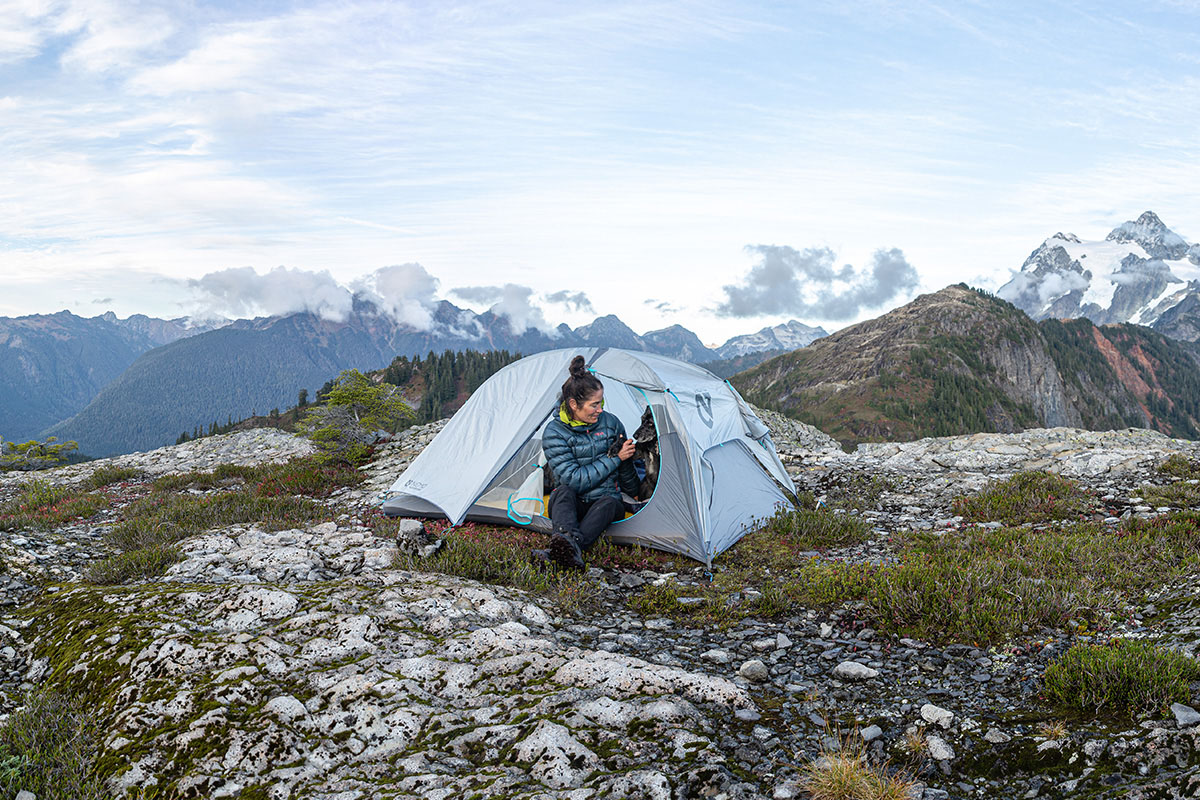
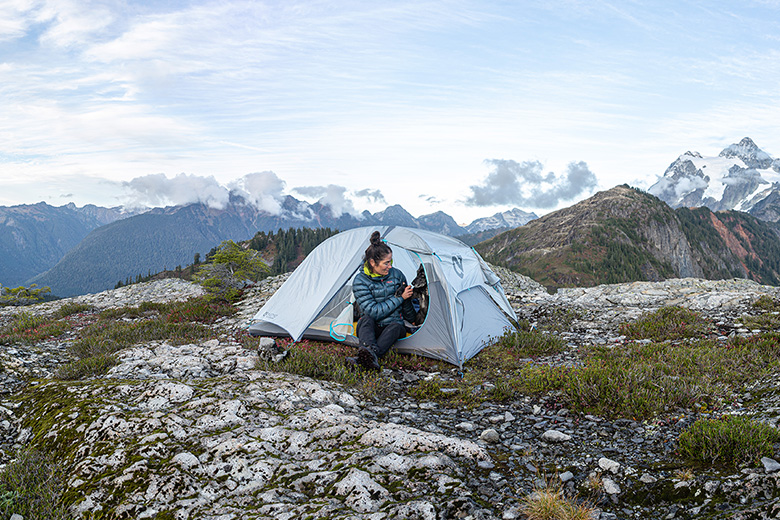
Price: $650
Packaged weight: 2 lb. 1.0 oz.
Floor area: 27.3 sq. ft.
Capacities: 1P, 2P
What we like: Remarkably lightweight without feeling ultra-compromised.
What we don’t: Pricey, fragile fabrics and components, and a tight squeeze for two.
See the Nemo Hornet Elite Osmo 2P
Nemo is a consistent leader in the backpacking and ultralight tent spaces, with their Hornet Elite Osmo 2P slotting in as an excellent choice for fastpackers and other weight-conscious minimalists. For just over 2 pounds, the Hornet Elite provides reliable double-wall protection alongside convenient features like two doors and vestibules and a fairly easy set-up process. Though tight for two adults and a steep investment at $650, it kept us cozy and dry on fast-and-light trips into the Yukon and more leisurely outings in the North Cascades. Below we outline our experiences with the Hornet Elite Osmo 2P. To see how it stacks up to the competition, check out our articles on the best ultralight tents and best backpacking tents.
With a packaged weight of just 2 pounds 1 ounce all in, the Nemo Hornet Elite Osmo 2P is remarkably lightweight, giving it a barely-there feel when stashed in a pack. The specialized construction comprises a mesh-heavy tent body, light but strong DAC Featherlite poles, and Nemo’s Flybar pole clip that does a great job boosting headroom while keeping weight to a minimum. Unsurprisingly, the flip side is that there are very few features to speak of, and the fabrics are on the thinner end, but both of these are par for the course with ultralight tents. In other words, while there are certainly some sacrifices to the design, I feel Nemo did a great job making the tent feel relatively complete at a truly impressive weight.
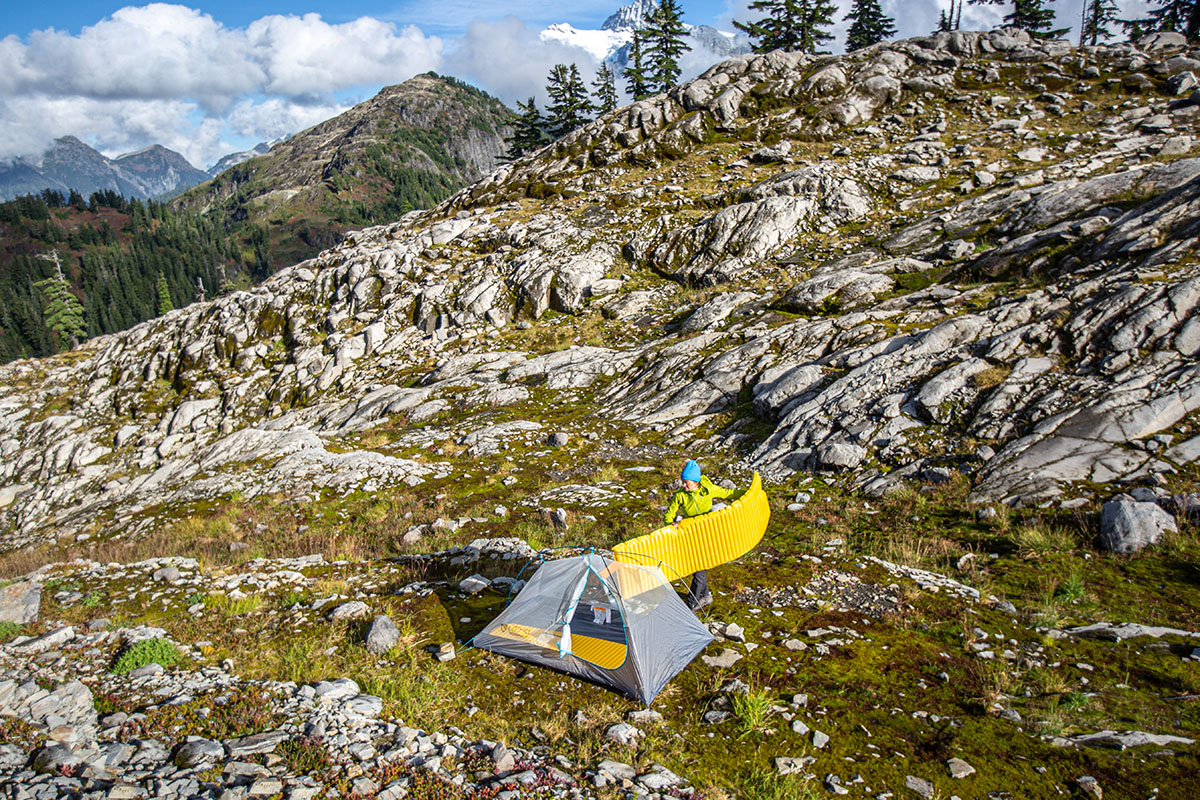
Weight and packed size often line up closely, and the Hornet Elite Osmo is no exception at 19 by 4 inches in its stuff sack. For comparison, this is on par with other semi-freestanding ultralight tents including Big Agnes' Tiger Wall UL2 (18 x 5 in.) and MSR's FreeLite 2 (18 x 4.5 in.). In practice, the tent was small enough that there was never an issue fitting it in my pack, even on fast-and-light adventures that required intentional packing.
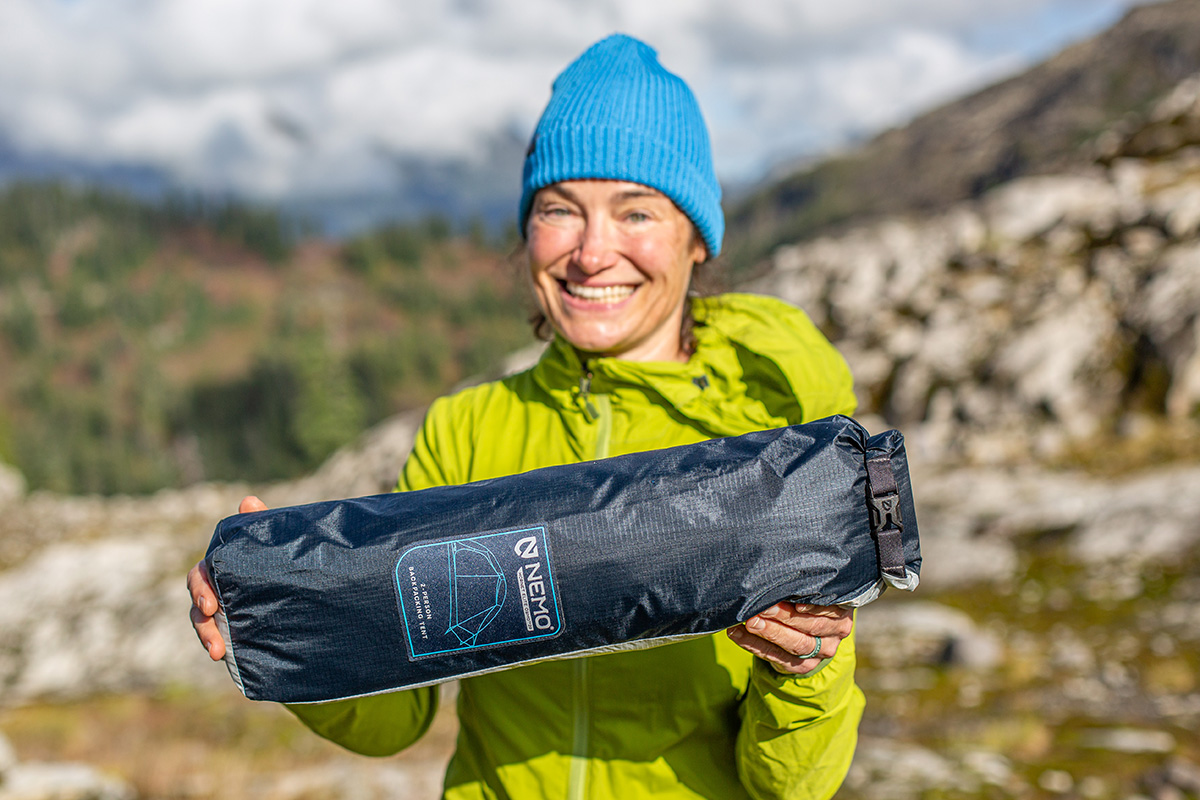
My husband and I have spent a fair bit of time in two-person backpacking tents and are almost always willing to take on the weight penalty of a three-person model when available for the additional space. Unfortunately, the Hornet Elite Osmo is only offered in one- and two-person capacities, so we opted for the latter. Unsurprisingly, the minimalist design was a fairly tight squeeze, although we did manage to fit two adults as well as our 50-pound dog, Otis, for a couple nights when our sitter fell through.
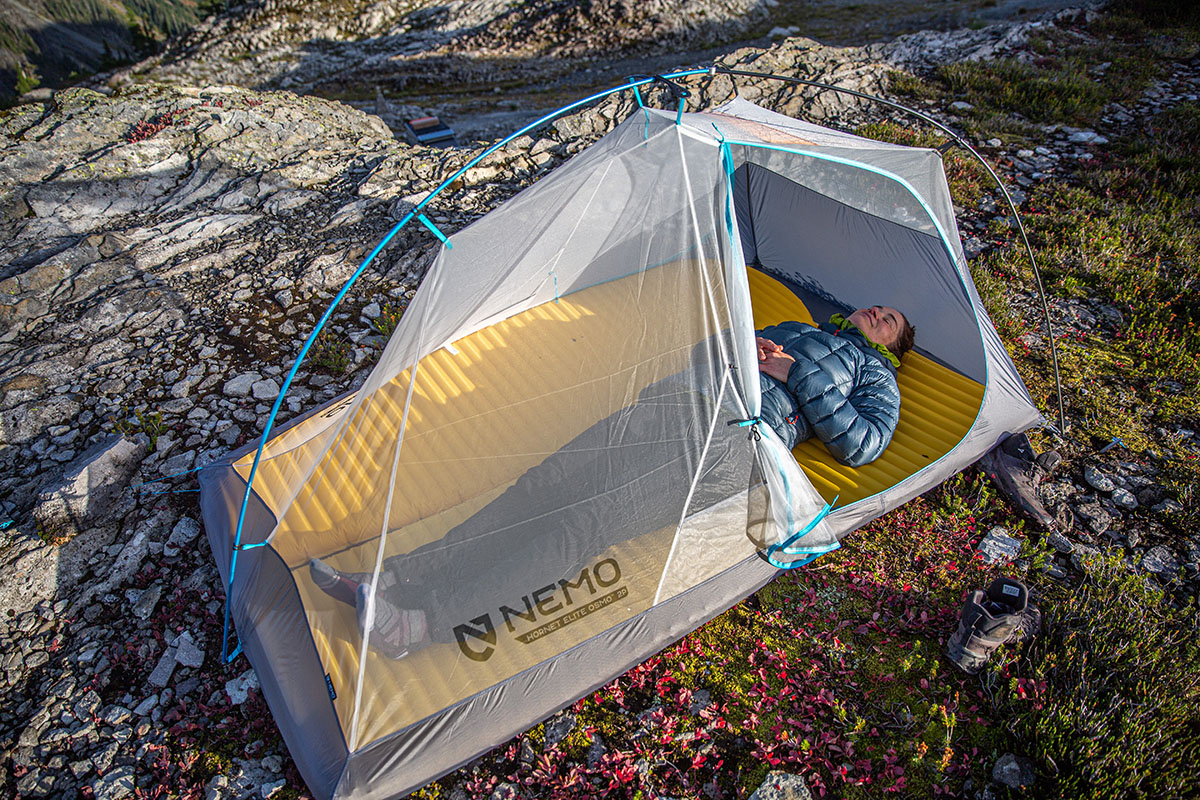
In terms of dimensions, the Hornet Elite Osmo 2P has a floor area of 27.3 square feet with an 85-inch length and 50-inch width at the head end that tapers down to 42 inches at the feet. For reference, my husband is 6 feet tall and didn’t have much space at his feet. He also found that sleeping on his back resulted in his toes touching the wall, which is something to keep in mind if you’re on the taller side. Widthwise, our two Therm-a-Rest NeoAir XLite NXT sleeping pads (one mummy-shaped and one rectangular) barely fit side by side, requiring one to overlap the other, although opting for two mummy pads would have helped. At its peak, the ceiling measures a modest 37 inches. The short Flybar mentioned above helps pull the walls up and away at the center, but a larger ridge pole—like what you get with Nemo’s heavier Dagger—would do a better job maximizing headroom (at the cost of added weight).
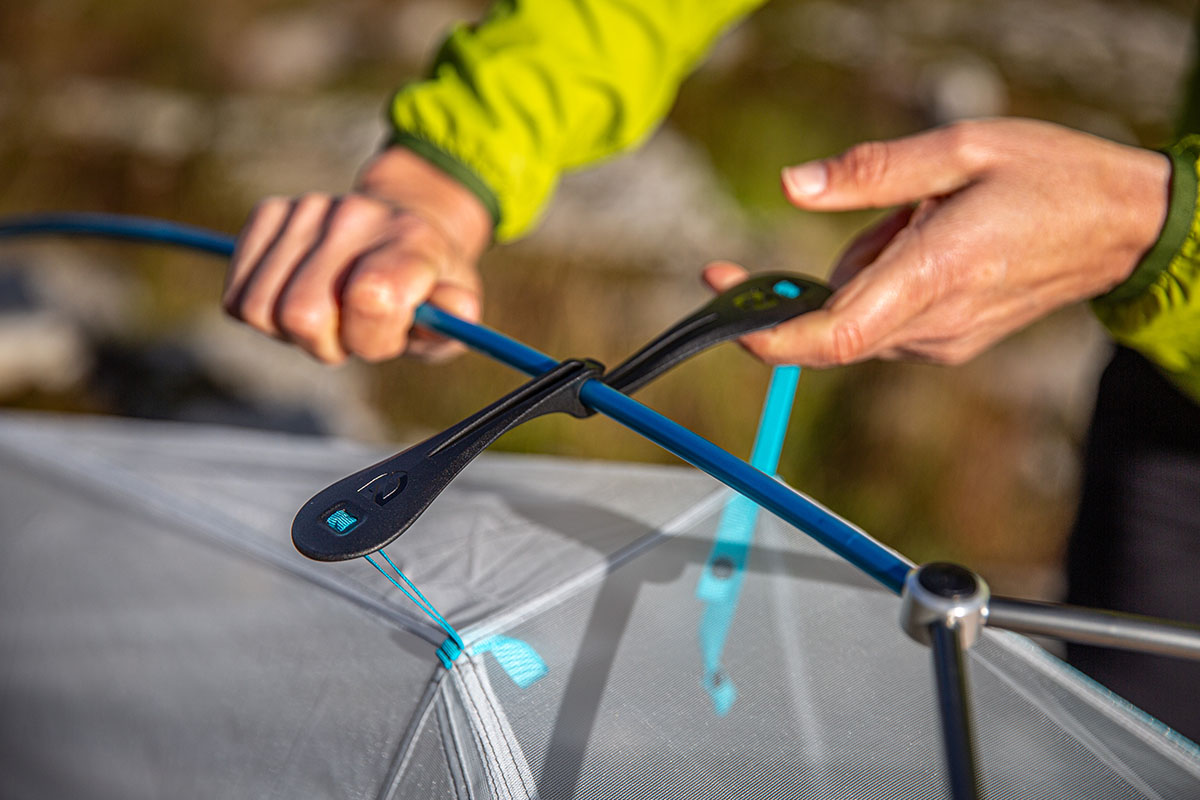
To be fair, Nemo did include some thoughtful design features to help boost overall livability. First, the bathtub floor is stretched out at the corners with triangulated guylines that create a vertical wall at the footbox. In addition to providing a bit of added space, I found the design effectively protected our feet and sleeping quilts during sideways rain. There are also two clips that connect the tent body to the rainfly to pull the sidewalls outward. I found the system a little finicky in use, but it does what it’s designed to do.
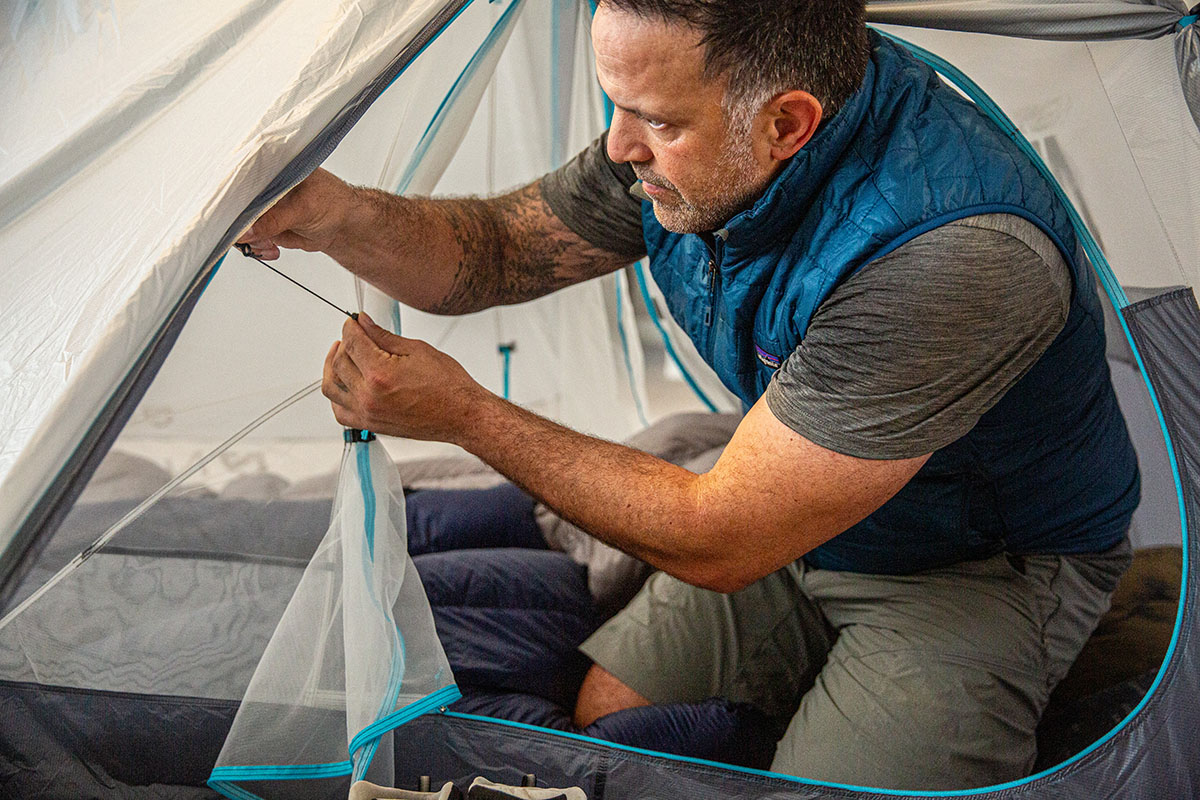
Ultralight gear often uses thinner fabrics and components to shave weight, and the Hornet Elite Osmo 2P tent is no exception. It’s difficult to assign an accurate denier (D) rating since the Osmo fabric uses two types of yarns, but I’d estimate it’s comparable in thickness to tents like Big Agnes' Tiger Wall UL2, which features a 15D floor and rainfly that require care to avoid damage. In fact, the Hornet Elite suffered a small tear when removing my backpack from under the vestibule, causing the pack’s zipper to snag on the fly. The hole is very small but serves as a clear reminder of the tent’s fragility. Otherwise, the rest of our tent is holding up well, from the DAC Featherlite poles to the mesh-heavy body and attachment points.
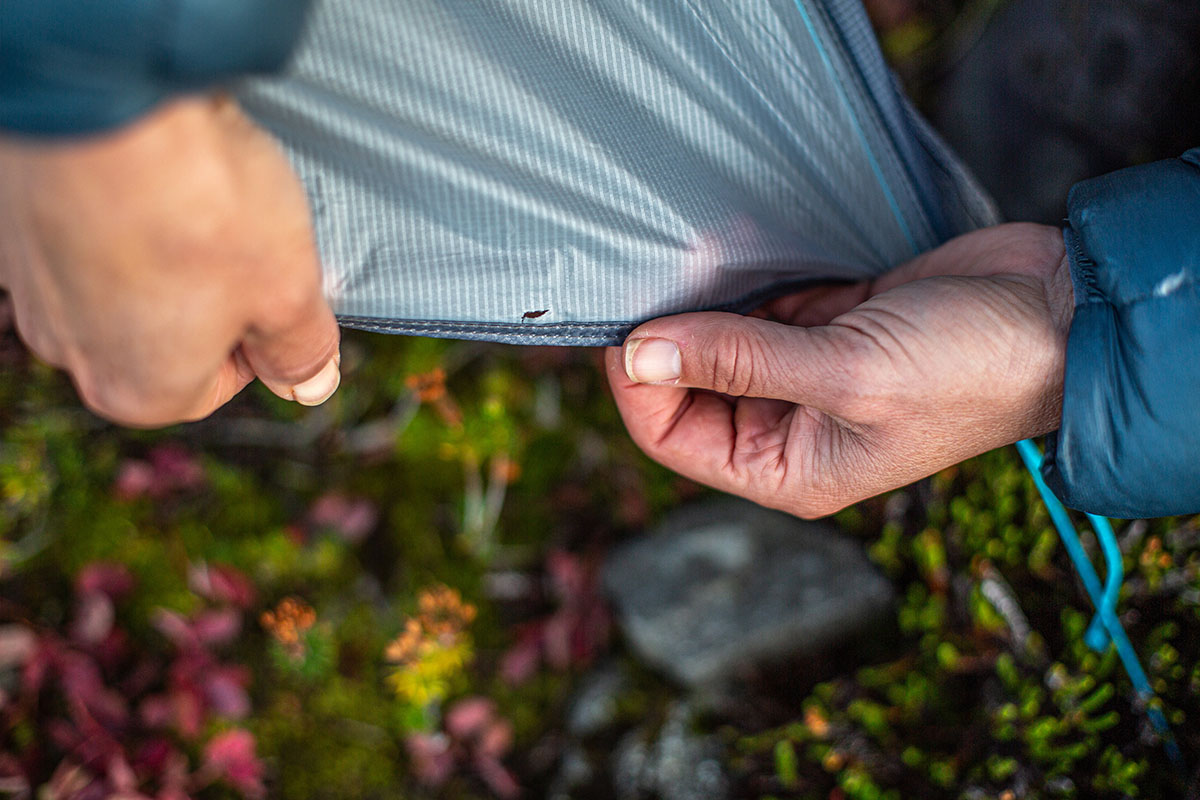
Despite its low weight, the Nemo Hornet Elite Osmo 2P proved to be a reliable wet-weather performer during a trip to the North Cascades in inclement weather. At one point, we awoke to a windstorm coupled with a torrential downpour. While it was difficult to fall back asleep, the tent fended off the strong gusts and sudden deluge without issue, keeping us perfectly dry inside. It can be tough to trust the poles as they bend and sway in the wind, but the tent held strong even when essentially flattened against us during particularly strong gusts.

The Hornet Elite’s namesake Osmo fabric is comprised of a polyester-nylon ripstop material that’s intended to boost water resistance and stretch less when wet (it’s also free of harmful “forever chemicals,” which we cover in more depth below). While it’s hard to substantiate these claims, all I can say is that it worked: Rain beaded up and rolled off the fly with no threat of wetting out the fabric, and all of our gear stashed in the vestibules remained dry during storms (with some careful arranging to ensure everything was fully covered). As with other semi-freestanding designs, we found it best to position the head end of the tent toward the wind to minimize any sail-like effect. In gusty weather, it’s also a good idea to attach the fly to the poles via the Velcro tabs, which help keep the two pieces together.
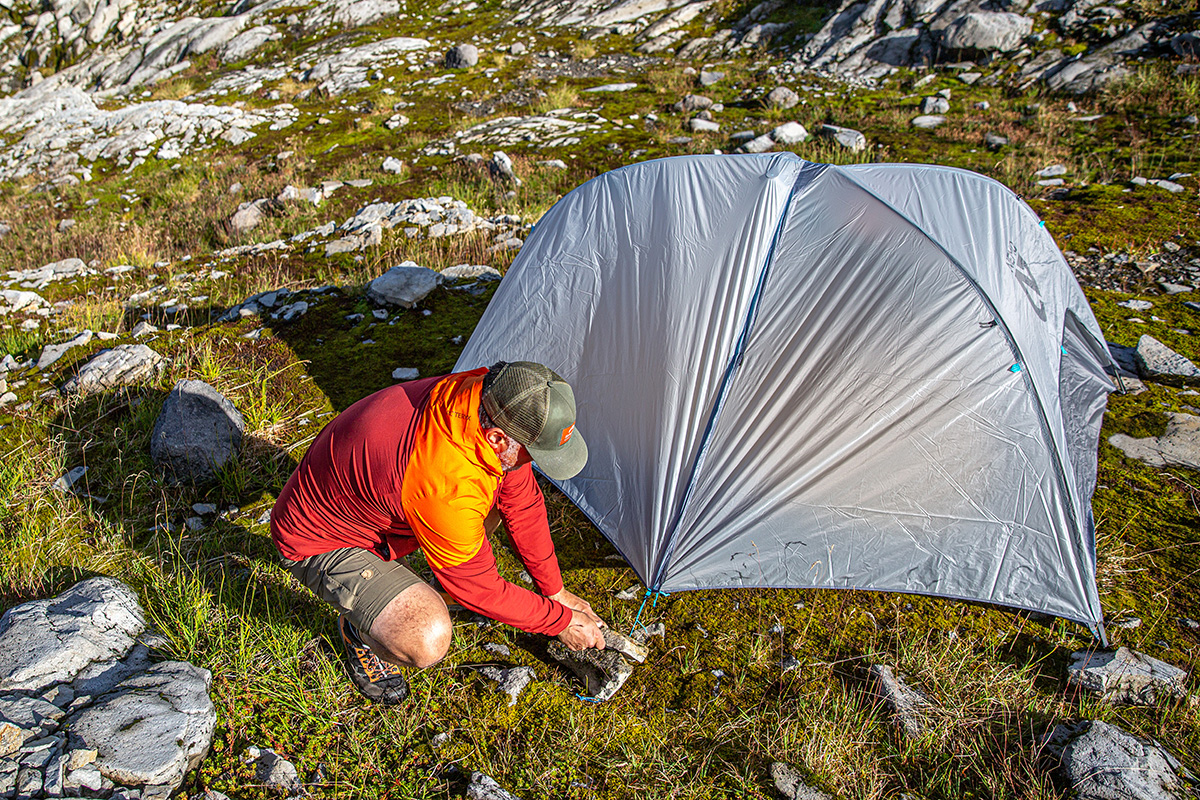
It’s worth noting that the Hornet Elite’s rainfly is slightly raised at the head and foot ends—similar to what you get with the brand’s Dagger Osmo tent and MSR’s FreeLite 2. While we had no issues with moisture making its way inside the tent, we did notice that the cutouts allowed wind to funnel in below the fly, causing some draftiness. A final point you’ll want to be aware of is that the single pole at the foot end can get blown around a bit. Ensuring the corners are securely staked out will help reduce movement, and it’s a good idea to utilize all of the guylines in blustery conditions.
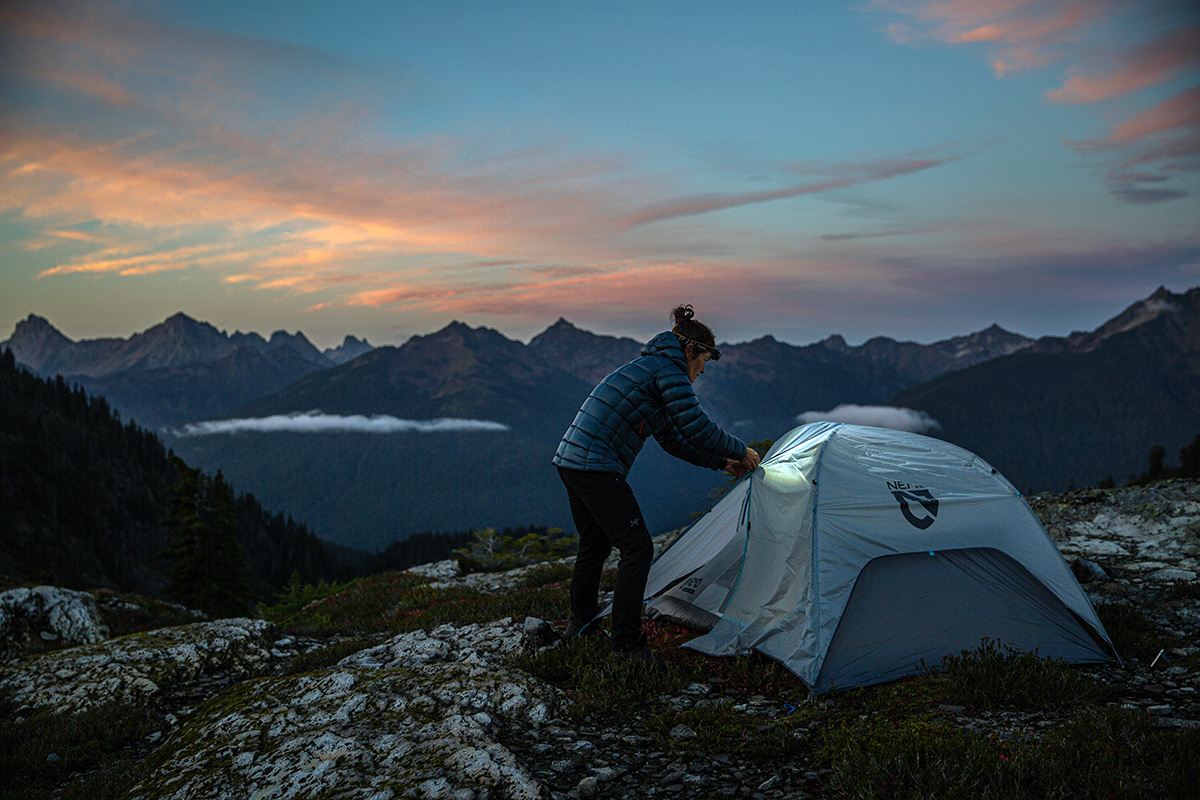
The Hornet Elite Osmo's sidewalls are made almost entirely of mesh, translating to top-notch ventilation when conditions are favorable enough to ditch the rainfly. Even with the fly on, we had no issues with condensation buildup inside the tent. We did find the tent to be a bit drafty during strong winds, which is likely due in part to the raised ends of the fly that leave some of the bathtub floor exposed to the elements, but this seems like a reasonable trade-off for the high level of breathability.
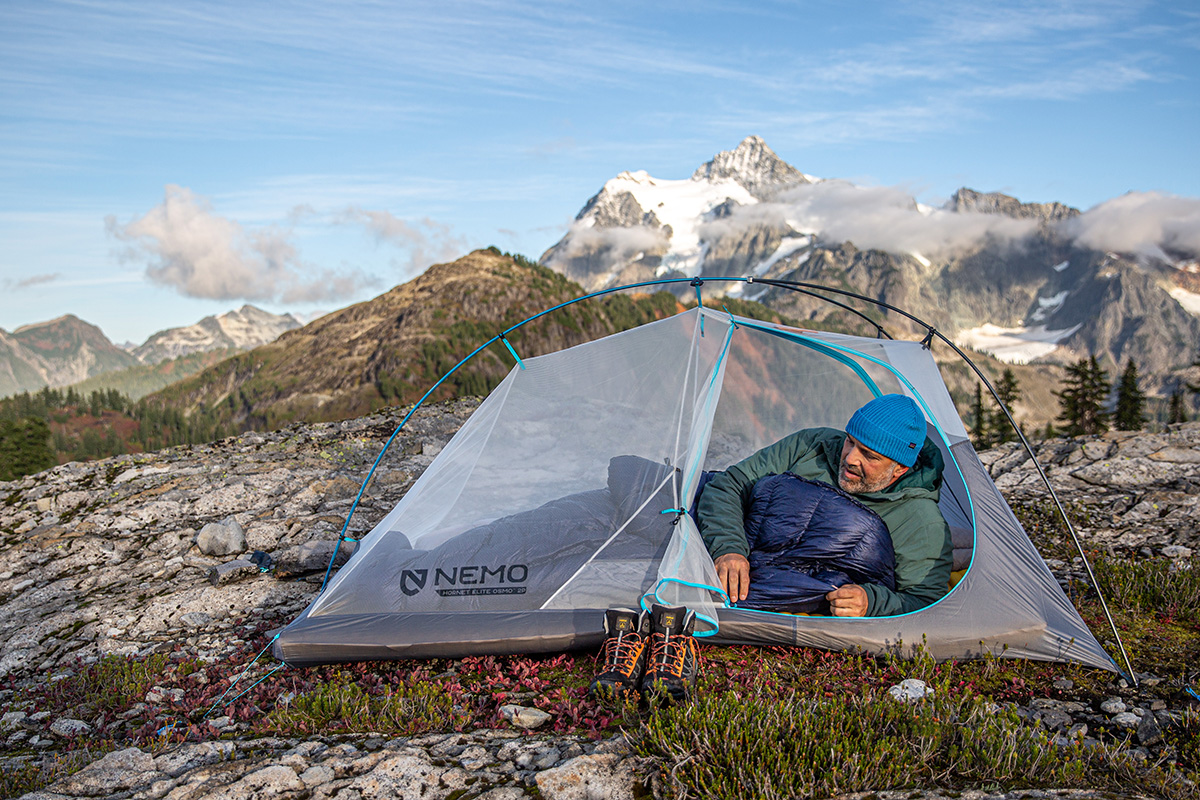
Despite its decidedly streamlined design, the Hornet Elite Osmo 2P comes with two doors and two vestibules, which is far and away our preferred layout for two campers. Each vestibule offers 6.2 square feet of storage space, which was ample for our pared-down fastpacking kits but a little snug for a full-sized pack and other bulky gear like a cook set. Inside the tent, there are two small pockets (one on each door) for stashing items like a phone or satellite messenger device, along with a Nightlight pocket overhead that can be used for storage or diffused illumination from your headlamp. All told, while certainly on the minimalist end, the layout gets the job done for those used to packing light.
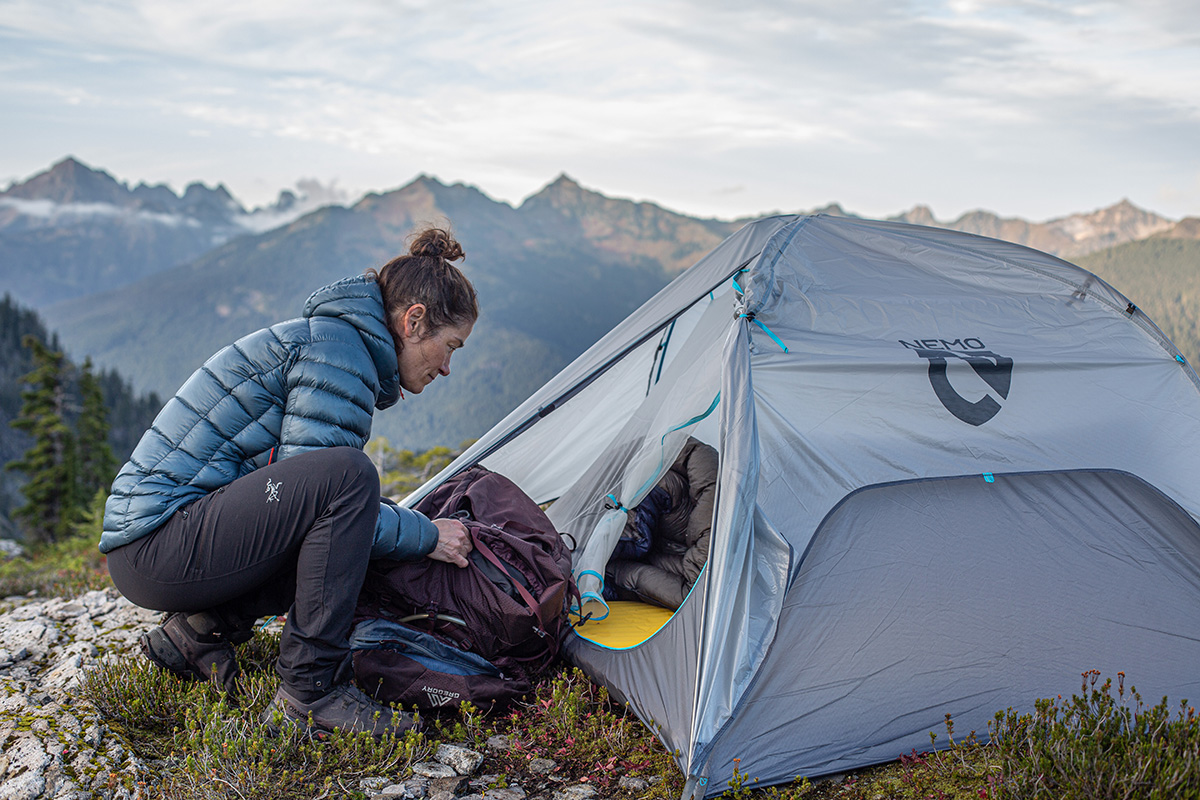
The Nemo Hornet Elite Osmo 2P is a semi-freestanding tent, requiring the corners at the foot end to be staked out in order to create the structure. This can be difficult or even impossible on certain surfaces (like rocky slabs), requiring large rocks to hold the stakes in place. In strong winds, you’ll also need to find rocks to secure the guylines. We used to simply wrap our tent’s guylines around rocks but found that this can cause damage from friction during strong gusts, resulting in a torn guyline on our Nemo Hornet Osmo 3P—a larger and heavier alternative to the Hornet Elite—in notoriously windy Patagonia (see our in-depth review for more details).
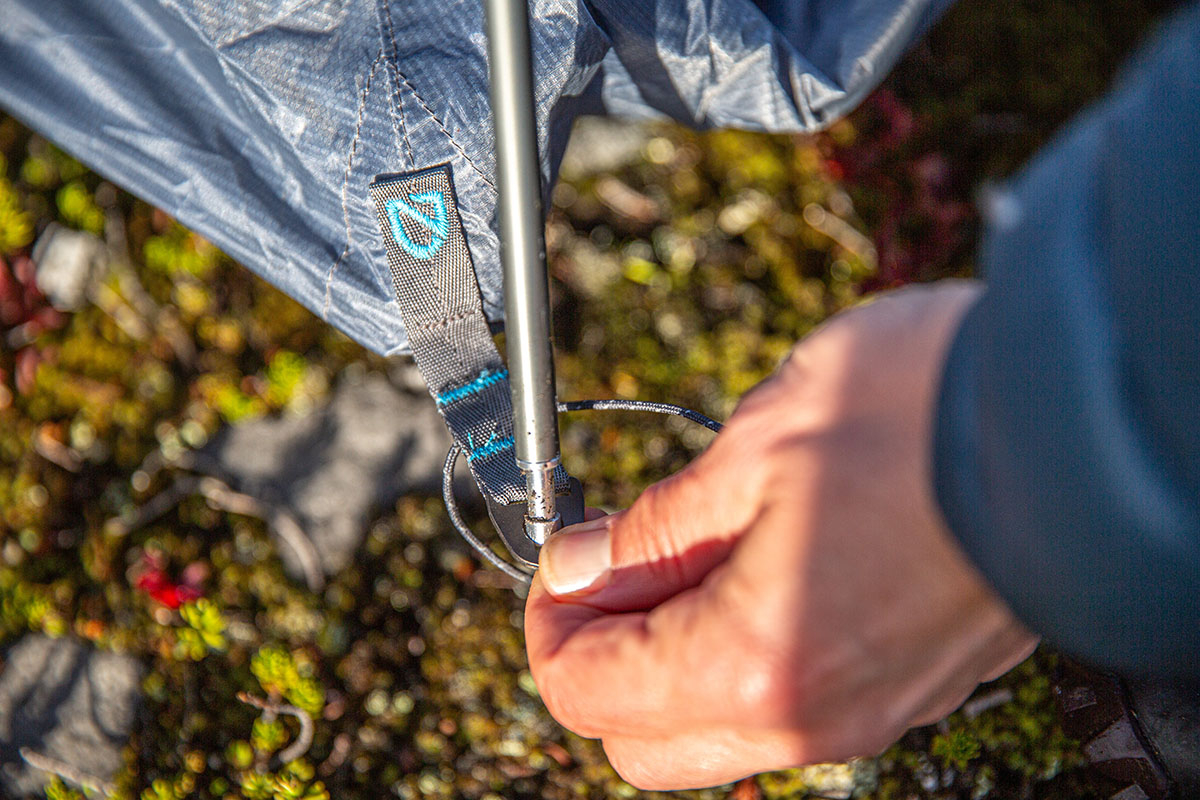
Sleep surface aside, the Hornet Elite Osmo 2P is pretty intuitive to set up, making it easy to erect in a hurry if need be. The poles connect with a single hub and are color-coded, making it very obvious which piece goes where. Once inserted, the poles create the frame from which the tent body is suspended via plastic hooks. My only complaint is that the tent comes with six stakes, leaving three of the guylines unsecured. This may not be an issue in favorable weather, but you’ll want to bring along additional stakes for guying the tent out if the wind picks up.
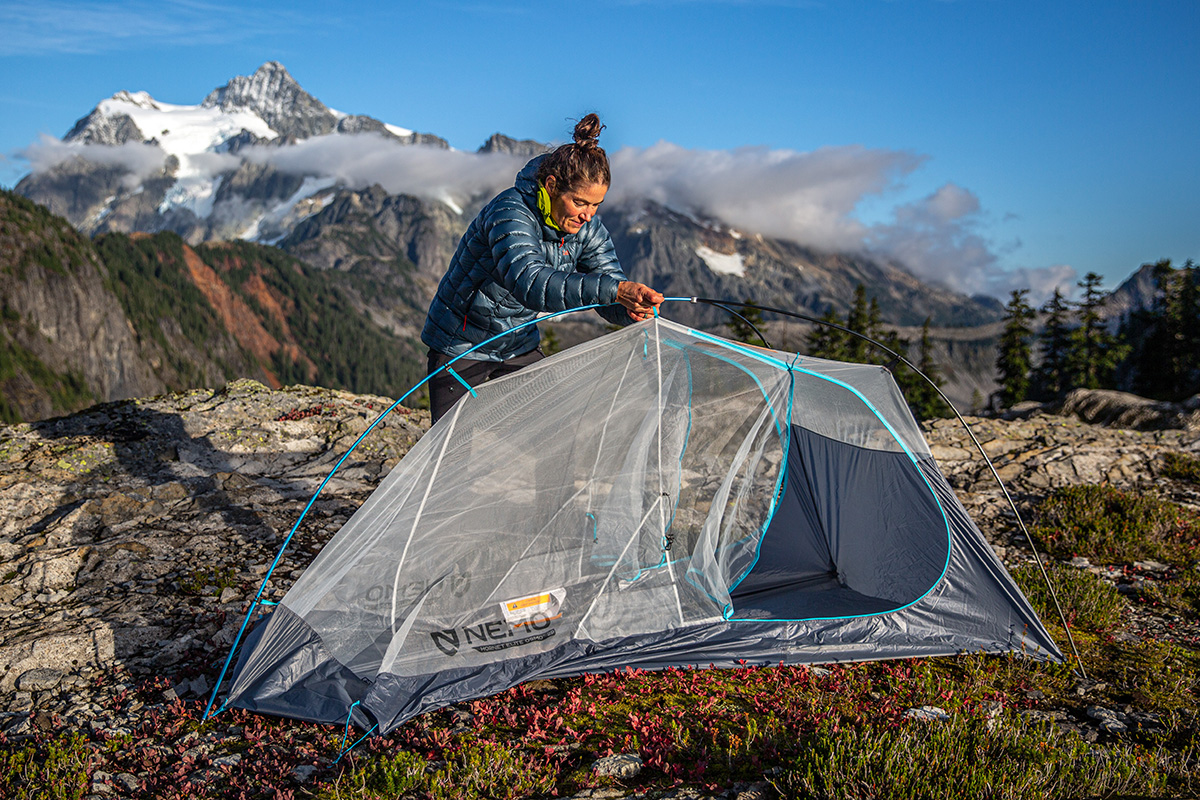
Nemo has positioned themselves as one of the most sustainably minded tent brands in the industry, and the Hornet Elite Osmo is a case in point. Specifically, the Osmo fabric is woven from 100%-recycled yarns that are PFAS-free, which means they forgo the use of harmful “forever chemicals” found in traditional water-repellent coatings. The Repreve pole bag is also 100% recycled—part of Nemo’s 100K Polybag Elimination Project that’s aimed at replacing single-use packaging. Taken together, we applaud Nemo for thinking outside the box and continuing to integrate more environmentally friendly materials into their lineup.
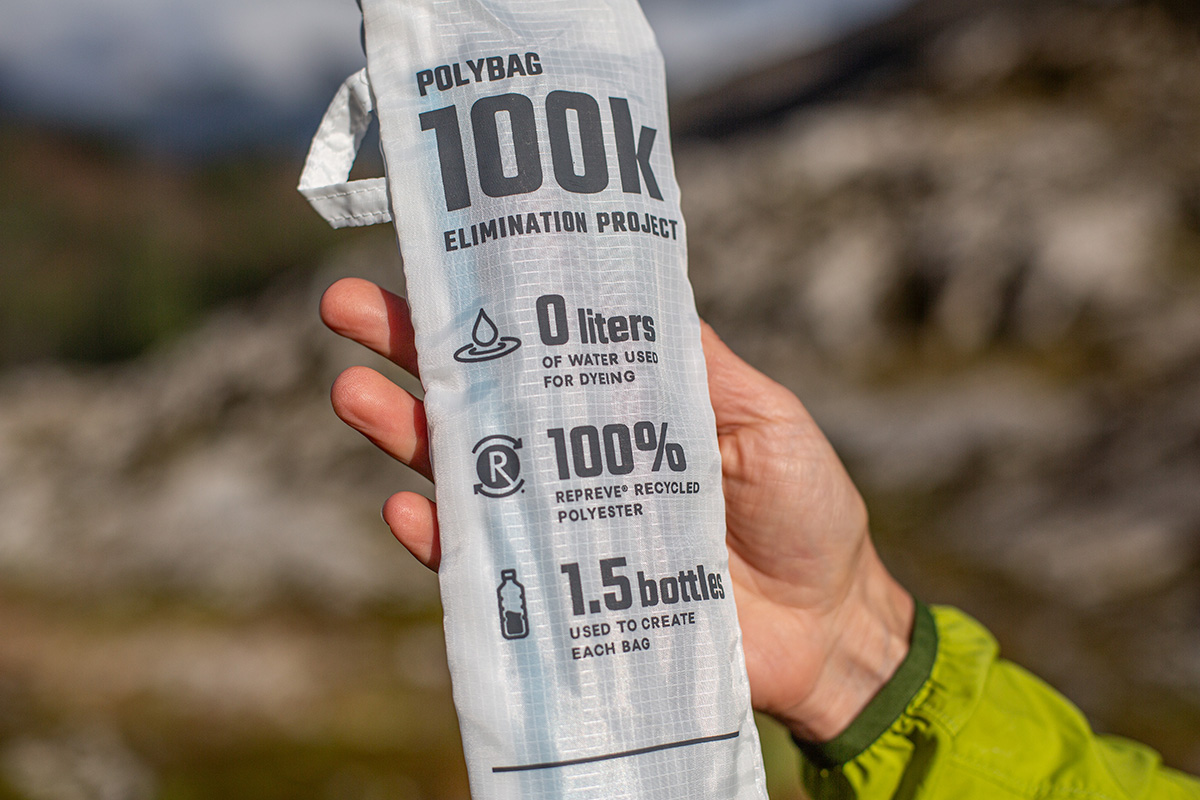
We tested the two-person Hornet Elite Osmo for this review, which is also sold in a one-person capacity for $550. The Hornet Elite Osmo 1P has a packaged weight of just 1 pound 13 ounces, boasts 21.8 square feet of floor space with a single 6.9-square-foot vestibule, and has a peak height of 39 inches, which is 2 inches more than the two-person model. If you’re willing to shoulder a little more weight, the standard Hornet is sold in one, two, and three-person capacities, with the Hornet Osmo 2P checking in at 2 pounds 8 ounces all in. This tent is slightly larger than the Elite model with a 27.7-square-foot interior and 39-inch peak height, and you also get an additional 1.8 square feet of vestibule space split between the two sides—all for $220 less than the Elite.
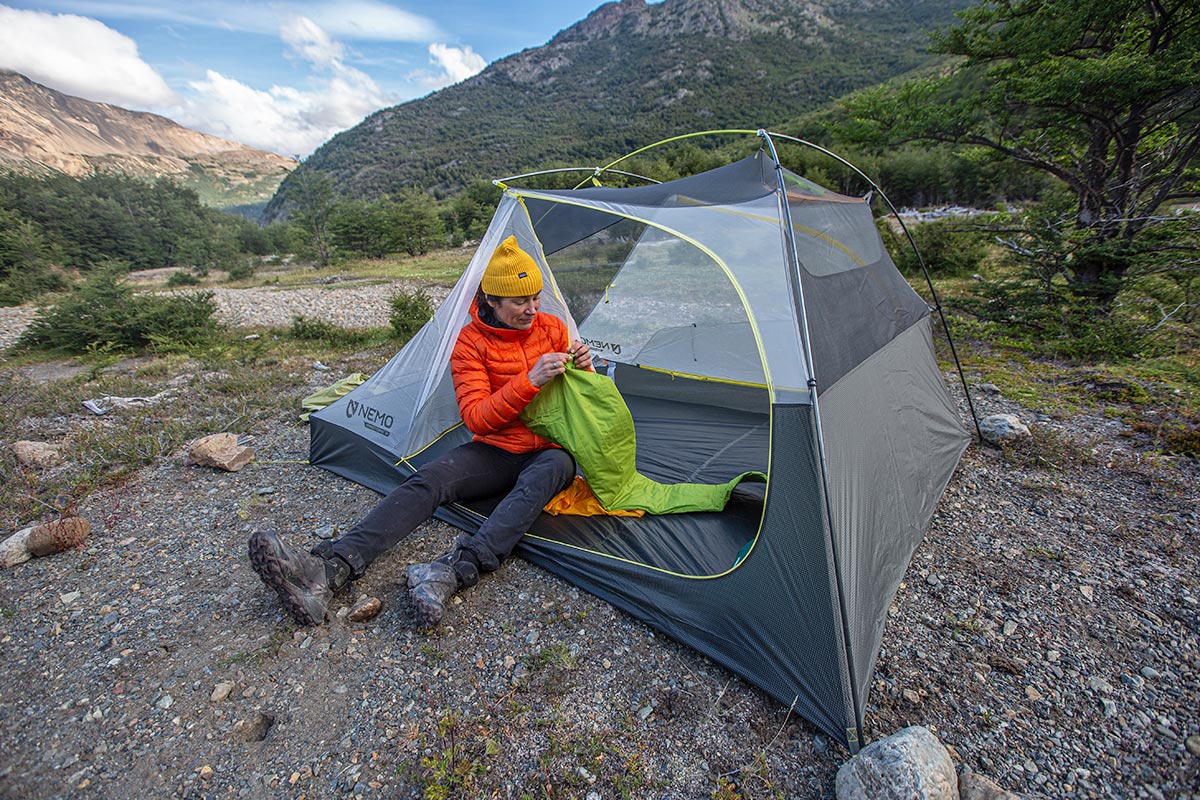
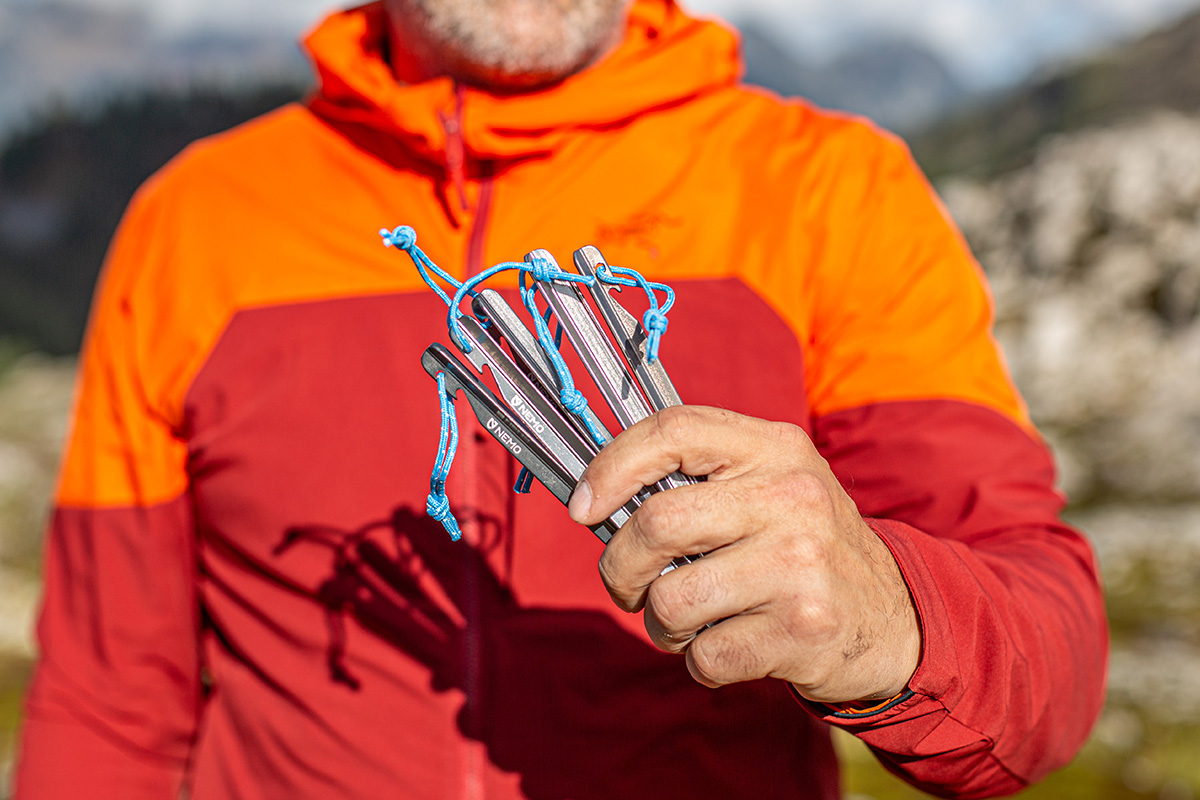
| Tent/Shelter | Price | Category | Weight | Floor Dimensions | Fly Fabric | Capacities |
|---|---|---|---|---|---|---|
| Nemo Hornet Elite 2P | $650 | Semi freestanding | 2 lb. 1.0 oz. | 85 x 50/42 in. | Poly/nylon blend | 1P, 2P |
| Zpacks Duplex Zip | $729 | Trekking pole | 1 lb. 4.4 oz. | 90 x 45 in. | DCF (.55/.75 oz.) | 2P, 2+P, 3P |
| Big Agnes Tiger Wall UL2 | $480 | Semi freestanding | 2 lb. 8.0 oz. | 86 x 52/42 in. | Nylon (15D) | 1P, 2P, 3P |
| MSR FreeLite 2 | $450 | Semi freestanding | 2 lb. 5.0 oz. | 84 x 50 in. | Nylon (15D) | 1P, 2P, 3P |
The Hornet Elite Osmo 2P is a highly competitive ultralight tent—enough so that it tops our UL tent rankings. That said, you can go even lighter with a trekking pole-supported design like the Zpacks Duplex Zip. While even pricier than the Hornet Elite at $729, the Duplex checks in at a scant 1 pound 4.4 ounces, excluding stakes. Despite this, it manages to retain impressive livability with a symmetrical 90- by 45-inch interior that offers a spacious platform for two. The Duplex also utilizes high-end Dyneema Composite Fabric, which is lauded in the UL world for its impressive strength-to-weight ratio and inherent waterproofing capabilities. The Duplex is definitely more involved than the Hornet Elite—the trekking pole set-up isn’t as intuitive, and the single-wall construction is lacking in breathability (plus, the door vents make it hard to boost airflow in inclement weather). Taken together, the Hornet Elite strikes us as the more approachable option, especially for those coming from traditional backpacking tent experience.
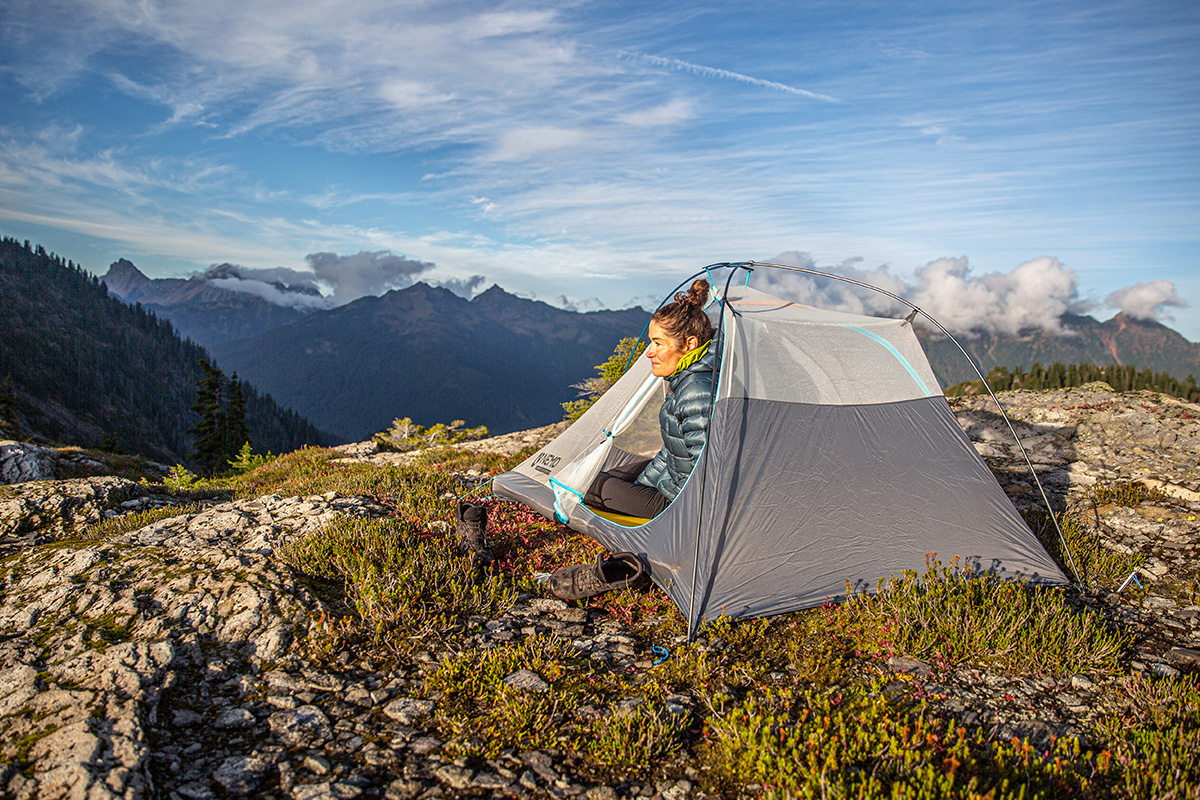
Moving back to semi-freestanding options, Big Agnes’ Tiger Wall UL2 and MSR's FreeLite 2 both compete fairly closely with the Hornet Elite. Starting with the Tiger Wall, you get a small bump in livability—including a 28-square-foot interior, a 39-inch peak height, and two 8-square-foot vestibules—although weight goes up by 7 ounces. The Tiger Wall does undercut the Hornet Elite in price by a significant $170, but ounce-counters and other discerning minimalists will likely be happier with the Nemo. For a nice middle ground, MSR’s FreeLite 2 checks in at 2 pounds 5 ounces, shares the same 39-inch peak height as the Tiger Wall, and offers 29 square feet of floor space, which is more than both the Hornet Elite and the Big Agnes. It also costs a fairly reasonable $450, although we came away a little disappointed by the tent’s lack of headroom and middling windy-weather performance in testing (for more, check out our in-depth FreeLite 2 review). In our opinion, the Nemo is the most competitive option of the bunch.
Back to the Hornet Elite Omso 2P Review See Our Ultralight Tents Guide